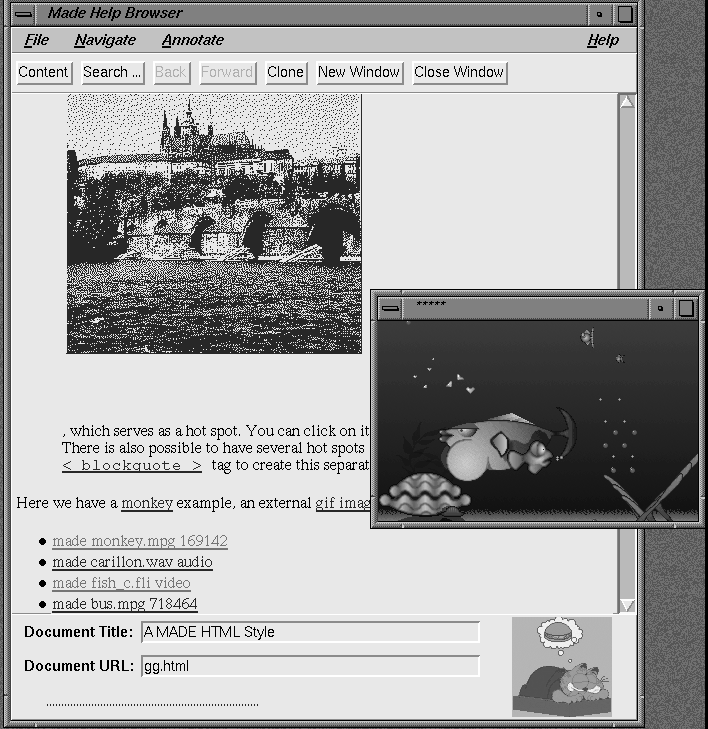

ERCIM News No.25 - April 1996 - CRCIM
HIT Browser
by Michal Haindl
HIT is a WWW portable and controllable browser
which was developed as a part of the ESPRIT III project 6307 MADE (Multimedia
Application Development Environment). The MADE project aims to design and
implement an open portable object-oriented development environment for multimedia
applications divided into toolkits and utilities level and also includes
a help system. It is designed to be a world-wide distributed restricted
(without synchronization) hypermedia system with additional support for
run-time object monitoring (internal run-time object state) and contextual
help (structured help information relevant to an interactive situation).
All MADE help toolkits use some subset of functionalities of the browser.
The browser is used to present selected pieces of help information from
a potentially world-wide distributed hypermedia-style document. The browser
is a C++ object with mutually exclusive execution in the thread of its caller
(realised in the form of C++ extension), but it can be used as a stand-alone
program similarly to other WWW browsers (eg Mosaic, Netscape, etc).
The browser has features common to other WWW browsers, like HTML parsing,
hyperlink following, remote date retrieval, external data playing, personal
annotations, history, hot-list, keyword search capability, data conversion,
etc.
Besides these common features it also has some unique ones. The browser's
control protocol enables dynamic modification of its behaviour. For example,
it is possible to temporarily suspend some browser activities, change the
meaning of some user action, use the running browser to retrieve and display
a new document or use some browser functionality (eg format conversion,
data printing, etc) for another application purpose. One simple application
of this feature can be access restriction for some users. Others are ignoring
external viewer spawning if the network is overloaded, and data content
dependent actions. The browser can be controlled from a script instead of
a user in this way it can automatically retrieve large data files overnight,
etc. The remote control protocol also enables a dynamic reconfiguration
of the user interface. It is possible to iconify the browser, to make it
invisible, to remove or restore some browser functionalities such as elements
in pop-up menus and so forth.

The browser can directly use MADE specific media data (MADE server). However
this relies on the use of MADE media viewers and consequently DBO object
(a generic interface between the MADE environment and external databases)
in conjunction with some connected database. The browser does not use their
synchronization mechanism; it only retrieves and plays single media objects.
Using MADE media viewers enables the hideing of specific data formats but
their use is currently limited to local network data access only.
The graphical user interface using twelve different windows is written in
Tcl/Tk to be platform independent. The browser runs on several UNIX platforms
as well as in a Windows-NT environment. The standard browser usage starts
from the main window, but the browser can operate on any other functional
subset when used with some Help toolkit objects.
HIT is a platform independent WWW browser with full dynamic remote control.
Any subset of the browser functionality can be used by an application if
appropriate, even in the background without any visual presentation. Further
work is still needed to include missing Java and VRML support.
Please contact:
Michal Haindl - UTIA - Czech Academy of Sciences
Tel: +42 2 66052350
E-mail: haindl@utia.cas.cz
or Behr de Ruiter - CWI
Tel: +31 20 5924164
E-mail: behr@cwi.nl
return
to the contents page

